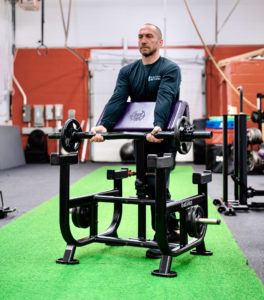Using Contrast Training for Stronger Arms

How to use a motor learning trick to lift heavier weights
While strength/power athletes and bodybuilders can understand the importance of learning anatomy, not many appreciate the topic of motor learning. Perhaps we can change their minds with the following discussion.
In his textbook Neuromechanical Basis of Kinesiology, Roger M. Enoka explains that the amount of force produced from a muscle that has been at rest does not represent its maximal force. “Rather, twitch force is maximal following a brief tetanus; this effect is known as posttetanic potentiation [PTP] of twitch force.” Got that? Translated, Enoka means that a stronger muscular contraction can be produced if that contraction is preceded by another contraction. Although a method commonly used in physical rehabilitation, PTP can also help make athletes stronger and more powerful.
One example of using PTP to improve sports performance can be seen when a baseball player warms up his swing with a bat that has weighed donuts attached to the end. This extra weight stimulates the fast-twitch muscle fibers. When the baseball player switches to a regular bat at the plate, they can swing faster and with more power. You can try PTP for yourself in the weightroom with a simple vertical jump test.
Start by testing your vertical jump. If your gym does not have a vertical jump mat or a Vertec, put some chalk on your fingertips, stand near a wall and jump as high as you can, touching the highest point on the wall with the fingers of one hand. Now do some squats, working up to about 80 percent for a set of 3 reps, rest a few minutes, then retest your vertical. You should find that you can jump significantly higher. (Oh, and be sure to clean off those chalk marks!)
Here is an example of how PTP can be used to build bigger and stronger arms with the use of thick-grip bars:
A1. Seated 45-Degree Incline Scott Curl, Thick EZ Bar, 1 x 6-8, 4010, rest 30 seconds
A2. BB Bench Press, Supine, Thick Bar, Close Grip with Chains, 1 x 4-6, 40X2, rest 120 seconds
B1. Seated 45-Degree Incline Scott Curl, 3 x 6-8, 4010, rest 30 seconds
B2. BB Bench Press, Supine, Close Grip with Chains, 3 x 4-6, 40X2, rest 120 seconds
Thus, the “A” series uses thick bars to stimulate the strongest muscle fibers without creating excessive fatigue, and those same fibers are active during the “B” series, enabling you to lift more weight.
Motor learning may not be the most exciting topic around the protein shake bar, but these examples show it pays for coaches, and also their athletes, to become students of the Iron Game. (TSS)
